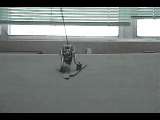When you descend the slope, check the following two points:
- Being aware of pressure in soles and external forces
- Anticipating the changes of external conditions
You need to mind not only the difference of pressures you feel between right and left soles but also its distribution inside each sole. Since your movement is very flexible thanks to soft XCD boots, the information coming from your soles relates directly to your body position you're taking. Be sensitive to the changes of the pressure in your soles always.
Though I'm not going to describe the matters of physics in detail, it would be beneficial for you to know the following external forces acting on you.
- driving force, or a force component of gravitational force
- reactive force you get from snow surface
- drag you get in your feet depending on snow conditions
- centrifugal force
Second sensing the changes of the reactive force from snow surface is important to tell the timing of turns. When the reactive force, such as buoyance in powder and repulsion from consolidated snow, is about to reach the maximum, that is the sign for you to initiate next turn.
Third the drag depends on snow conditions. If you ski on groomed surface, you feel little drag from snow. On the other hand if you ski on powder, you feel drags in your feet that would let you tumble forward in the worst case. The changes of drags caused by snow conditions can be sensed by your front ski as you make telemark turns. The drags may change according to the changes of hardness, lightness and stickiness of snow. The lighter snow gets, the more actively you can move.
Fourth the centrifugal force may not be a big issue because the speed of XCD is usually low.
Try not to angulate actively like you do on alpine skis or you'll fall down inside curving arc.
Don't fight against these external forces.
For example, don't make abrupt turns while the earth is wanting you to move along with fall-line. Transition from one motion to another should be always smooth. However, it may be difficult for beginners to keep pace with the speed. Then pluck up the courage and cut-and-try. The cost of falling down is not so big for XCD.
If you aren't aware, you can't anticipate either.
The information of terrain and barriers can be got by sight mostly.
Therefore you need to look forward carefully.
Easier said than done. Many skiers are seeing the area just a few meters away from the tips of their skis. To anticipate well, look farther but not too far.
If you wear heavy gear of plastic and metals, you could remain dumb and short-sighted. However if you're on XCD, be aware and anticipate to develop you skill fast.







